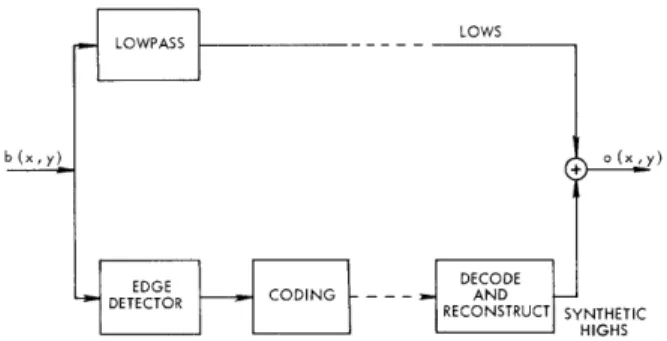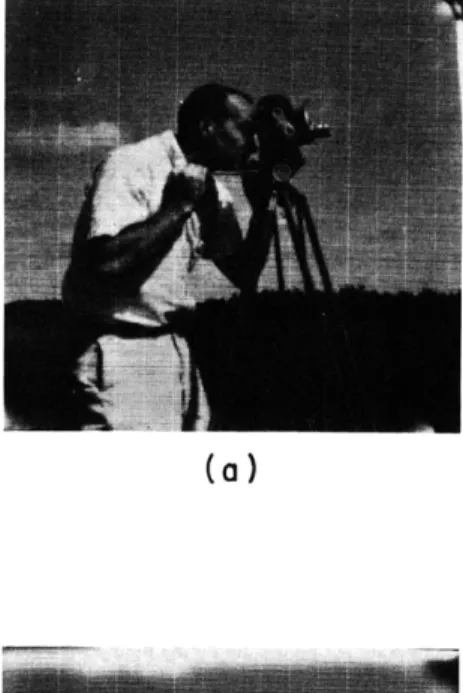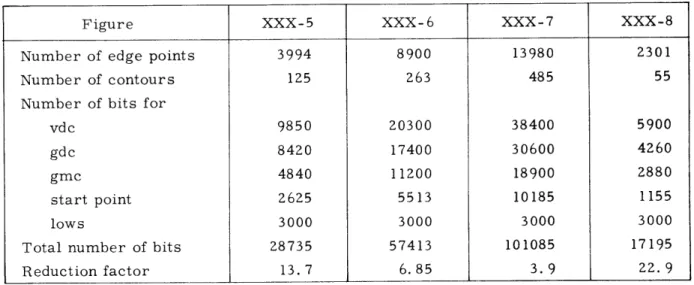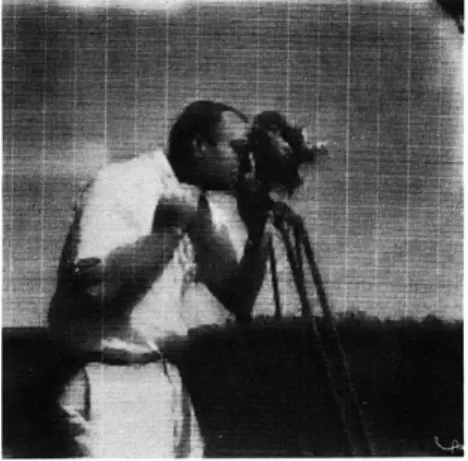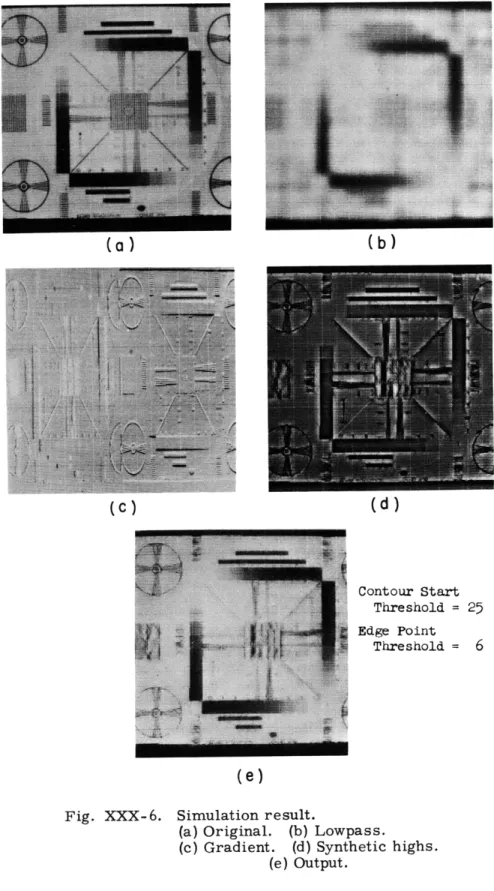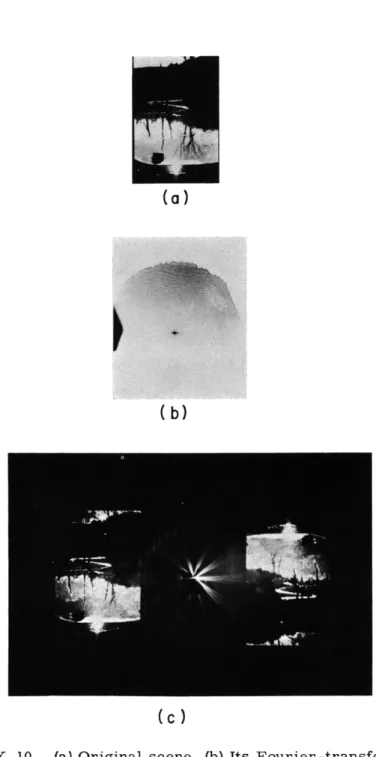XXX. COGNITIVE INFORMATION PROCESSING*
Academic and Research Staff
Prof. W. L. Black Prof. W. F. Schreiber Dr. P. H. Liss Prof. M. Eden Prof. D. E. Troxel Dr. O. J. Tretiak Prof. T. S. Huang Dr. K. R. Ingham C. L. Fontaine
Prof. F. F. Lee Dr. P. A. Kolers E. R. Jensen
Prof. S. J. Mason G. L. Wickelgren
Graduate Students
E. I. Ancona A. Gabrielian H. J. Rack
G. B. Anderson R. V. Harris III G. M. Robbins T. P. Barnwell III H. P. Hartmann A. H. M. Ross
A. K. Bhushan G. R. Kalan C. L. Seitz
B. A. Blesser R. W. Kinsley, Jr. D. Sheena
A. L. Citron J. I. Makhoul R. M. Strong
R. W. Cornew W. H. Lee G. A. Walpert
D. P. Dewan L. C. Ng J. A. Williams
D. L. Peterson
RESEARCH OBJECTIVES AND SUMMARY OF RESEARCH
The primary research interest of this group is in the real-time acquisition and pro-cessing of visual information for display to the visual and nonvisual senses, and in the psychology of human utilization of such information, for both communication and control. The motivation is an interest in human capabilities for information processing and in human information requirements. Applications include sensory-aids systems for the blind and the blind-deaf, picture-transmission systems, and special information-display systems for enhancement of human performance under conditions of stress.
Major projects now in progress include studies on reading machines, picture pro-cessing, pattern recognition, and automatic processing of visual data of significance in studies of biology and medicine.
1. Reading Machine Studies
Research during the past few years in the Cognitive Information Processing Group of the Research Laboratory of Electronics has led to the construction and operation of an experimental reading system for the blind. In its present configuration the system consists of a document-handling carriage, a flying-spot opaque scanner, a digital scan-ner control unit, and a gescan-neral-purpose medium-sized computer (PDP-1). Focusing, black-and-white threshold setting and document loading are manually controlled by a sighted operator. The scanner control unit operating under control of the computer pro-gram reports coordinate letter contour and other statistical information of the view in the scanner field. This information is used for the generation of signatures that are
searched in a signature table for the identification of the letters. The signature table is built up through training sessions. Identified letters are spelled out, one at a time, through the use of digitized speech samples. The present output rate of the spelled
(XXX. COGNITIVE INFORMATION PROCESSING)
speech is 60-80 words per minute. Experience has indicated an identification error rate of approximately 0. 3% with a type font which the machine has been trained on.
One long-term objective is to provide a real-time connected speech output for the reading machine. The steps required are the translation of English words in conven-tional spelling into phonetic spellings, the addition of intonation to utterances and the generation of synthetic speech. Other intermediate forms of outputs are also contem-plated.
Another objective for future research is to develop a field version of a reading sys-tem and evaluate its characteristics under conditions of actual use by blind subjects. This will involve consideration of the problems encountered by a blind operator in the adjustments of focus and threshold, the alignment of the document, and in specifying which portion of the text is to be read next. Naturally, considerable research will be
required both on the hardware and software of the present reading system before a field version is to be designed and constructed.
a. Character Recognition
The character recognition algorithm used in the reading machine system described above is being tested on several other type fonts, including news print. Variation of this and new algorithms will be investigated with a view toward further simplification
and applicability to multiple type fonts. Consideration will also be given to the problems of broken and touching letters.
b. Opaque Scanners
The character recognition work thus far has been carried out with a scanner that has a small field of view and is fairly slow. Work will proceed on other types of scan-ners which will allow less sophisticated document handling and a faster throughput of characters.
c. Tactile Displays
Two tactile displays are under development, both of which are two-dimensional arrays of Braille-like tactile "dot" elements, in which each dot is either present or absent, according to external control. The first display, made up of solenoid-controlled poke probes, has a size of 6 x 8 and is designed to present a Braille-like cell to each of 8 fingers. The second display is of the "moving-belt" variety, with size 64 X 128, and a frame rate of three or more per minute. These displays will be used as tactile outputs for the reading-machine system and also for general studies of tactile pattern perception, both dynamic and static.
d. Spelled-Speech Storage, Display, and Compression
Spelled-speech offers a slower, but simpler, auditory display than artifical speech. Under construction are magnetic and optical storage and read-out of the spoken-letter sounds, and the compression of spelled speech by sampling in sections, temporal
trun-cation, and temporal-overlap superposition has been examined. e. Phonetic Translation of English Text
The transliteration of spelled English words into phonetic spellings depends on the use of morphographemic rules, morphophonemic rules, as well as syntax and seman-tics. Although the dependence on semantics is relatively weak in an engineering sense, the dependence on syntax is heavy, in that intonation (a suprasegmental feature of speech
(XXX.
COGNITIVE INFORMATION PROCESSING)
such as English) cannot be determined without a certain amount of syntactic analysis. The problem of the selection of important morphographemic, morphophonemic, and syn-tactic rules, and the make-up of an accompanying morpheme lexicon are crucial to the generation of connected speech from text string input.
f. Artificial- Speech Generation
Rapid human adaptation to a sentence of synthesized speech under repeated exposure makes it very difficult for the experimenter himself to judge the quality and performance
of his synthesizer and the procedure used. A facility that allows the experimenter to input phonetic strings to the synthesizer and to manipulate the procedure parameters easily should allow better artificial speech to be synthesized. The development of the equipment and the accompanying computer program is part of the reading-machine research effort.
g. Real-Time Data-Processing Facilities
Work continues on the development of real-time remote input-output subsystems that make it possible for two small general-purpose digital computers to be utilized simul-taneously and cooperatively in the reading-machine system, one computer being mainly
occupied with scanner control, character recognition, phonetic translation, and the other with the generation of speech from phonetic symbolic input.
F. F. Lee, D. E. Troxel, S. J. Mason
2. Picture-Processing Studies
Picture-processing research is concerned principally with processing and encoding picture signals for efficient transmission, subject to a quality constraint in the received picture. Subsidiary matters concern picture processing for quality improvement or for feature recognition.
a. Picture Quality
Our long-range goal is to develop objective measures correlating with subjective rating of picture quality. As a preliminary goal, we need to establish subjective rating on a more satisfactory basis. At present, it is not possible to compare such evalua-tions made on different systems, using different subjects, different observers, at dif-ferent times. To facilitate such comparison, we plan to produce a new set of standard subjects. For each subject we shall produce a set of standard photographs in which the quality and data rate are varied, and in which, for each data rate, the system para-meters have been varied, for optimum quality. The system will be PCM, with additive random noise of uniform probability distribution. These sets of pictures should permit accurate evaluation of quality and coding efficiency of new systems by a matching pro-cess.
(XXX. COGNITIVE INFORMATION PROCESSING)
c.
Optical Image Processing
Our principal interest is in using optics as a tool for picture processing. In
partic-ular, we are interested in developing links between digital computers and coherent
optics so that the two can be used to complement each other. Applications under
con-sideration include matched-filter detection, and holographic television systems.
W. F. Schreiber, T. S. Huang
3.
Pattern-Recognition Studies
"Pattern Recognition" is a common theme underlying the projects described above,
whether the task is accomplished by human cognition, by computer data processing or,
most commonly, by a combination of the two.
Complementary to the task-oriented projects, the following research studies in the
general area of pattern recognition are being carried out.
a.
Psychophysics of Depth Perception
This project is designed to provide information on a subject's ability to make
accu-rate distance and orientation judgments with respect to real and illusory
three-dimensional objects.
The variation of such judgments will be studied without feedback,
as well as with a continuous auditory or visual error signal.
b. Effects of Spatial Transformation of Text upon Reading and Writing
Performance
It has been shown that systematic transformations or printed text (such as inversions
or rotations of letters and of words) produce regular changes in the learning rate, as
well as in the asymptotic reading rate. These studies are being extended to a wider
class of transformations and also to reading and writing performance, with cursive
script used as the text.
c.
Automatic Extraction of Information from Printed Sheet Music
With the aid of the scanner and ancillary equipment developed for the projects
described above, it is possible to program a computer to determine note value,
dura-tion, phrasing, and certain other music indicators from ordinary printed sheet music.
This study is being continued to see what additional parameters can be extracted by
automatic recognition.
d.
Cognitive Processes
-
Language Comprehension
Research will be directed toward clarifying the nature of the quick perception and
comprehension of written information by studying how normal and speed readers
inter-pret words and sentences presented tachistiscopically.
The ability to detect various
syntactic and semantic differences between a known sentence and a briefly presented
one will be especially studied.
e.
Visual Perception and Eye-Movement Relations
We shall explore the ability of the system controlling eye movements to learn to
follow points or scan lines whose positions are modified in determinate ways by
(XXX. COGNITIVE INFORMATION PROCESSING)
movement of the eyes. Of especial interest will be the effect of eye-movement adapta-tion on the percepadapta-tion of moadapta-tion and form.
M. Eden, P. A. Kolers, P. H. Liss
4. Biological Image Processing
Biological image processing deals with the acquisition and analysis of visual pat-terns that are important to medicine and biology. The picture-processing facilities described above are being used to explore the feasibility of using fully automatic tech-niques or machine aids to human classification of such objects as white cells, chromo-some counting, particle counting in micro-autoradiographs, and three-dimensional visualization of micro-anatomic structures.
a. Chromosome Project
As an exploratory venture into Biological Image Processing, we have started assembling a procedure for karyotyping human chromosomes. In particular, we are addressing ourselves to the problems presented by touching and overlapping chromo-somes. We hope to achieve our aim of distinguishing overlapping chromosomes by obtaining photographs in which the density in the overlap regions is different from that in the nonoverlapping regions, then to outline the chromosomes through appropriate programming.
b. Blood Cell Inventorying
The objective is to see if the distinctions between the various blood cells are suffi-ciently well understood to allow us to devise an automatic inventorying procedure. Standard blood smears stained with Wright's solution are photo-micrographed, and then scanned through three color filters on a flying-spot scanner. The digital data are then entered into the computer, where various algorithms will be employed to attempt sepa-ration. Ultimately, we hope to construct a computer-controlled microscope scanner.
c. Branching Structures
Algorithms have been devised for generating two-dimensional venation patterns such as are typified by tree leaves. The parameters of the algorithm serve as data for a possible classification of leaf type according to species. The work will be extended to measure the analogous parameters of actual leaves by picture-processing techniques.
M. Eden, W. L. Black, O. J. Tretiak A. REPRODUCTION OF GRAPHICAL DATA BY FACSIMILE*
There is a broad category of documentary and graphical data which is commonly transmitted by facsimile and in which only two brightnesses, black and white, exist in
to ofter
our-31.,
as
it
is
Ssehow
orW
to offer
-nr 4
Wa,
AS
i
l1i
t smeahow
or a
O Sea
the
as
xl~
2~~(a)
to
offer
our '
ess,
as it is
I
t s oehow
or o
a
send the
cha
This
is
indee
te
that
as soon
(C)
(b)
Sto
offer
our
'ess,
as
it
is.1
,t
seehow or o
Ssend
the
cha:
This
is
indee,
* that
as soon
(d)
(a) 70 samples/inch,
(b) 70 samples/inch,
(c) 200 samples/inch,
(d) 200 samples/inch,
continuous tone scale.
binary tone scale.
continuous tone scale.
binary tone scale.
These pictures should be viewed at approximately
twice normal viewing distance.
The resolution refers
to the original copy.
(XXX. COGNITIVE INFORMATION PROCESSING)
(analog) tone scale gives superior results. It is the purpose here to report some experi-ments along these lines and to present some preliminary conclusions.
Eight examples of original documents, including typing, book, newspaper, and mag-azine print, and several non-Roman scripts, were converted into transparencies, with careful attention paid to photographic quality, including sharpness, graininess, and the preservation of the original tone scale. These transparencies were then scanned at approximately 70, 100, 140, and 200 samples per inch (of the original) in each direction. The sampled data were displayed on a cathode-ray tube and photographed with the orig-inal continuous tone scale, and also quantized into various numbers of steps. Attention was given to comparison of the analog and two-level reproductions. The scanning aper-ture was small (sharply focussed) in all cases, but the reproduction aperaper-ture was made just large enough to reduce the visibility of the dot structure to a low level.
The results show that at the lower sampling densities analog transmission does give superior quality, but the difference between analog and binary reproduction becomes less as the sampling density increases. The two reproductions seem nearly comparable at 200 samples/inch or less, the difference depending on the copy. On the basis of these tests, we have reached the following preliminary conclusion:
Very high-quality transmission of graphical data is possible, by using discrete sampling in both directions with only two transmitted levels of brightness.
There is a subsidiary matter of importance in binary transmission, however. When only two brightness levels are used, the decision level of the quantizer is of great importance. Factors such as different reflectivity of background, color and darkness of ink, quality of print, focus, and so forth, make it highly desirable to use some local averaging to adjust the decision level to an optimum value. Preliminary qualitative work shows this approach to have merit. We hope to do further studies at a later date.
Some examples are shown in Fig. XXX- 1 above.
(XXX. COGNITIVE INFORMATION PROCESSING)
B. IMAGE TRANSMISSION BY TWO-DIMENSIONAL CONTOUR CODING
This research is an extension of the work done by J. W. Pan,1 as suggested by Professor W. F. Schreiber.2 A block diagram of the proposed system is shown in Fig. XXX-2.
LOWS
LOWPASS LOWS
b(x, y) ox ,y)
EDGE DECODE
DETECTOR CODING --- AND
RECONSTRUCT SYNTHETIC HIGHS
Fig. XXX-2. Block diagram of the proposed system.
In this system an image is treated as a two-dimensional signal of the spatial coor-dinates x and y. The large changes in brightness in a picture occur at the edges of objects and are accentuated by the visual system. The edge points can be isolated by the gradient or Laplacian operator. The fact that these edge points lie along connected con-tours in two dimensions is used to code the location and characteristics of each point
efficiently. Two-dimensional reconstruction filters are derived to synthesize the high-frequency picture from the decoded-edge information. A two-dimensional lowpass or out-of-focus picture is also formed which can be transmitted with a relatively small number of bits. After a possible accentuation to make the picture appear "sharper," the "synthetic highs" signal is added to the lowpass picture to yield the final output. A reduction in the total number of bits required to describe a picture by a factor of 4 to 23 is possible as compared with 6-bit PCM.
The pictures used in this investigation were flying- spot.- scanned, quantized to 256 levels, which permits an 8-bit representation, and recorded on digital magnetic tape by the picture-processing equipment constructed in our laboratory. The IBM 7094 II
and other facilities of the Computation Center, M. I. T. , were used to process these pic-tures, and the equipment in our laboratory was used to display and photograph the out-put from the simulation. Limitations of core storage and processing speed led to the choice of pictures that were sampled with a 256 X 256 array.
The lowpass filter,
f(x,
y), used in this study was a circularly symmetric Gaussian function with a- = 4 samples. This spreads over approximately 10 per cent of the pic-ture height. The original and the lowpass pictures are shown in Fig. XXX-3. In an earlier report3 it was shown that the gradient operator could be used as an edge(a)
(b)
Fig. XXX-3.
(a) Original picture.
(b) Lowpass picture.
(XXX. COGNITIVE INFORMATION PROCESSING)
detector and that it is possible to reconstruct the high-frequency part of the picture by operating on the gradient signal with a two-dimensional linear filter. It is also possible to use the Laplacian operator and to derive a reconstruction filter for this signal.4
The principal edges in a picture lie along contours in two dimensions which are con-tinuous. A large "contour start threshold" is set to isolate the important edges in the
picture. After finding a point for which the magnitude of the gradient exceeds the con-tour start threshold, the neighboring points are examined and the concon-tour extended in the direction of the maximum magnitude. This process continues until no neighbor point
exceeds the "edge-point threshold" when an "end-of-contour" signaLis sent. The starting point is examined again to see if the contour extends in the opposite direction to that first taken.
In transmitting the location of the contour points a great deal of advantage can be taken of their connectivity. The beginning point of a contour requires 16 bits to specify its location, although some sort of two-dimensional run-length coding could reduce this. The first sample on the contour can be in any direction, so that 3 bits are necessary to specify this. Because contours tend to be long, straight or curved lines, it is expected that the next point will lie in the same direction as the last, or perhaps 450 to either side. A variable-length code can be generated to describe these vector direction changes (vdc) efficiently. At any point that is on a contour, the gradient is quantized into 4 possible magnitudes and 8 directions. Since we expect the gradient to be in the same direction along a contour with occasional changes, the gradient direction change (gdc) can be coded in the same way as the vdc. In fact, changes in these two quantities are probably highly correlated. Since we search for the maximum value of the magni-tude along a contour, we can also expect that to change slowly. An efficient code for the gradient magnitude change (gmc) can be derived from the conditional probabilities
Table XXX- 1. Contour coding data for the figures.
Figure XXX-5 XXX- 6 XXX-7 XXX-8
Number of edge points 3994 8900 13980 2301
Number of contours 125 263 485 55
Number of bits for
vdc 9850 20300 38400 5900
gdc 8420 17400 30600 4260
gmc 4840 11200 18900 2880
start point 2625 5513 10185 1155
lows 3000 3000 3000 3000
Total number of bits 28735 57413 101085 17195
Fig. XXX-4.
Output picture reconstructed after
tracing and quantizing.
Contour Start Threshold
=
38
Edge-Point Threshold
=
12
Fig. XXX-5.
Two-dimensional bandlimiting.
Reduction Factor
=
16
(a)
(b)
(C)
(d)
Contour Start
Threshold = 25Edge Point
Threshold = 6(e)
Fig. XXX-6.
Simulation result.
(a) Original.
(b) Lowpass.
(c) Gradient.
(d) Synthetic highs.
(a)
(b)
(c)
(d)
Contour Start
Threshold = 25Edge Point
Threshold = 6(e)
(a)
(b)
(c)
(d)
Contour Start Thresnold = 25 Edge Point Threshold = 6(e)
Fig. XXX-8.
Simulation result.
(a) Original.
(b) Lowpass.
(c) Gradient.
(d) Synthetic highs.
(XXX. COGNITIVE INFORMATION PROCESSING)
of change from each level.
The output picture with a reduction factor of 13. 7 as compared with 6-bit PCM is shown in Fig. XXX-4. A similar bit reduction by two-dimensional bandlimiting is illustrated in Fig. XXX-5.
Figures XXX-6, XXX-7, and XXX-8 show other input pictures and the results of processing. The synthetic highs were accentuated by 1. 2 before being added to the lows to give the output pictures. The coding data and bit reduction for each is given in Table XXX-1.
The reduction factor in bit rate over 6-bit PCM as calculated in Table XXX-1 should increase with a higher resolution system. For an n X n picture the total number of points goes as n , while the number of points on the edges is proportional to n. Thus if not many new contours were found in a 512 X 512 picture the reduction factor would approximately double over that found with a 256 X 256 picture.
D. N. Graham References
1. J. W. Pan, "Picture Processing," Quarterly Progress Report No. 61, Research Laboratory of Electronics, M. I. T., July 15, 1962, p. 229.
2. W. F. Schreiber, "The Mathematical Foundation of the Synthetic Highs System," Quarterly Progress Report No. 68, Research Laboratory of Electronics, M. I. T., January 15, 1963, p. 140.
3. D. N. Graham, "Two-dimensional Synthesis of High Spatial Frequencies in Picture Processing," Quarterly Progress Report No. 75, Research Laboratory of Elec-tronics, M.I.T., October 15, 1964, p. 131.
4. D. N. Graham, "Image Transmission by Two-dimensional Contour Coding," Ph.D. Thesis, Department of Electrical Engineering, M. I. T., September 1966.
(XXX. COGNITIVE INFORMATION PROCESSING)
C.
FOURIER-TRANSFORM REPRESENTATION OF PICTURES
With the appearance of the Cooley-Tukey algorithm,l which reduces the number
of
operations in the machine calculation of Fourier series, possibilities for
new
investi-gations in picture processing have presented themselves.
The use of PCM picture
trans-mission has been well investigated.
2Now, given an array of numbers, constituting a
sampling of image brightness levels, the Fourier series may be determined for a
peri-odic, two-dimensional, discrete function generated from the array. This Fourier
series
Fig. XXX-9.
(a) Original picture used in the study.
(b) Result of 5-bit quantization on conventional
PAM samples.
(c) Result of 5-bit quantization on Fourier
series samples.
(a)
(XXX. COGNITIVE INFORMATION PROCESSING)
will be periodic in two dimensions also. If the image was properly bandlimited before sampling, then the two-dimensional period of the Fourier series, centered around the DC term, is a sampled version of the Fourier transform of the original unsampled image. The coefficients in a period of the Fourier series, which are, in general, complex, are equal in number to the samples taken of the image. The transform of a real function obeys a symmetry condition, F(u, v) = F (-u, -v), where F(u, v) is the two-dimensional transform with frequency variables u and v, and * denotes conjugation. This allows representation of the periodic two-dimensional Fourier series by only one-half of the coefficients in any period of the series. Instead of using N real numbers to represent a picture, N/2 complex numbers may be used by Fourier analysis.
Of interest is the result of quantization on picture quality when Fourier series samples are used for picture representation. Partial results in this investigation have been obtained. Figure XXX-9a is the original picture used in this study. This picture was sampled to form a 64 X 64 array and then quantized to 5 bits per sample. A linear
interpolation scheme was then used to obtain the picture in Fig. XXX-9b. Figure XXX-9c was obtained by first calculating a Fourier series using 'the 64 X 64 sample array, quan-tizing the series samples to 5 bits, inverting the series to get a picture array, and then finally interpolating. Figure XXX-9b and 9c are seen to be comparable, thereby
indi-cating that the Fourier series samples are no more susceptible to quantization noise than are conventional PAM samples. The degradation of Fig. XXX-9b and 9c with respect to Fig. XXX-9a is due not only to quantization but also to the heavy aliasing in the sampling process.3 It is expected that at least a slight improvement is possible for Fig. XXX-9c by using a readjustment of quantization scale, since some of the Fourier series samples were well out of range.
The sampling array was limited to 64 X 64, because of memory limitations of the IBM 7094 computer.
G. B. Anderson
References
1. J. W. Cooley and J. W. Tukey, "An Algorithm for the Machine Calculation of Com-plex Fourier Series," Mathematics of Computation, pp. 297-301, April 1965.
2. T. S. Huang, "PCM Picture Transmission," IEEE Spectrum, Vol. 2, No. 12, pp. 57-63, December 1965.
3. O. J. Tretiak, "The Picture Sampling Process," Sc. D. Thesis, Department of Elec-trical Engineering, M. I. T. , 1963.
(XXX. COGNITIVE INFORMATION PROCESSING)
D. EFFECT OF MULTIPATH ON HOLOGRAM TELEVISION SYSTEMS 1. Introduction
There are three reasons why one might want to transmit a hologram of a scene instead of a conventional picture of the scene.
(i) Although the hologram itself is two-dimensional, the reconstruction of the orig-inal scene can be made three-dimensional.
(ii) The effect of channel disturbances on the quality of the reconstructed picture of a hologram television system will be different from its effect on the received picture of a conventional television system. In certain cases, the degradation in picture quality in a hologram TV system may be more acceptable than that in a conventional TV system.
(iii) A hologram may be more amenable to certain bandwidth compression schemes than a conventional picture.
In order to exploit the second point mentioned above, it is necessary to find out how various channel disturbances will affect the reconstructed picture in a hologram TV sys-tem. In this report, we present some preliminary results on the effect of multipath or echo on the reconstructed picture of an analog hologram TV system.
2. Theoretical Analysis for Fourier-Transform Holograms
Let f(x,y) be the light (amplitude)distribution, as a function of the spatial coordinates x and y, which we wish to reconstruct at the receiver. Then, except for some scale factors, the Fourier-transform hologram of f(x,y) is
H(u,v) = F(u,v)+A e-jau 2, (1)
where F(u,v) is the Fourier transform of f(x,y), u and v are the spatial frequencies, and A and a are real constants. The term in the right-hand side of Eq. 1, which is
responsible for the reconstruction, is 1
H1(u, v) = AF(u,v) ejau. (2)
If the hologram is scanned (in the v-direction, say), and transmitted in analog fashion, and if there are two different transmission paths, then the received hologram will be
r (u, v) = H(u, v) + bH(u, v-d), (3)
where b and d are real constants. The term on the right-hand side of Eq. 3, which is responsible for the reconstruction, is
Hrl(u,v) = [AF(u,v)+ AbF(u,v-d)] ejau (4)
(a)
(b)
(c)
Fig. XXX- 10.
(a) Original scene. (b) Its Fourier-transform
holo-gram. (c) Reconstruction from the holoholo-gram.
(XXX. COGNITIVE INFORMATION PROCESSING)
g(x,y) = f(x,y)(l+bcosdy) + jbf(x,y) sin dy. The observed intensity distribution then is
[g(x,y) 2 = (1+b 2 + 2bcosdy) f (x,y)2 .
Therefore, the reconstructed scene is the original scene multiplied by a biased sine
wave. It will contain fringelike structures, the spacing of the fringes being dependent
on d, the delay of one of the transmission paths.
The case of more than two
trans-mission paths can be analyzed in a similar way.
3.
Experimental Results
The case just discussed was simulated on an optical bench.
An apparatus was
arranged to make Fourier-transform holograms of a transparency.
The multipath was
simulated by shifting and double-exposing the film in the hologram plane.
Figure XXX- 10 shows the original scene on the transparency, its Fourier-transform
(a)
(b)
(a)
(b)
Fig. XXX- 11.
(a) A two-path hologram.
(b) Its reconstruction.
Fig. XXX- 12. (a) Another two-path
holo-gram (with smaller
delay).
(b) Its reconstruction.
hologram, and the reconstruction from the hologram. Figures XXX- 11 and XXX-12 show
two simulated two-path holograms and their reconstructions.
The delay, d, in
(XXX.
COGNITIVE INFORMATION PROCESSING)
clearly exhibit the fringelike structures predicted by Eq. 6.
4.
Fresnel Holograms
A similar analysis of a Fresnel hologram indicated that the effect of multipath in
that case is twofold: The reconstructed picture will contain ghost images just as in a
conventional TV system, and the overlapping areas of the images will contain
fringe-like structures.
T. S. Huang, P. L. Stamm
References
1.
T. S. Huang and B. Prasada, "Considerations on the Generation and Processing of
Holograms by Digital Computers," Quarterly Progress Report No. 81, Research
Laboratory of Electronics, M.I.T., April 15, 1966, p. 199.
E.
OPTICAL SPATIAL FILTERING FOR SIMULTANEOUS DELAY AND
DOPPLER ESTIMATES OF RADARLIKE SIGNALS
Optical processors have been recognized in recent years as efficient tools for
per-forming spectral analysis and linear filtering, particularly when the data to be
pro-cessed are two-dimensional.
1Both coherent and incoherent systems are possible,
although the coherent systems are generally more useful. These systems have found
application in various kinds of pattern recognition, analysis of nuclear particle tracks
in bubble chamber photographs,
3analysis of seismic data,
4processing of video signals
in synthetic aperture radar,5 and pulse compression (matched filtering).6
Fig. XXX-13.
Space-domain filter function from
which the frequency-domain filter
was constructed; actual size,
(XXX. COGNITIVE INFORMATION PROCESSING)
the Fourier-transfrom properties of a lens were used to generate the spatial frequency
spectrum of an input signal, and the filtering was done in the frequency plane.
Computer-generated space-domain filter function transparencies (see Fig. XXX- 13) were made
with our laboratory's picture-processing equipment, and the frequency plane filter was
made photographically with the same optical equipment used for the filtering. Both the
signals and frequency plane filter were recorded by modulation on carriers. The signal
used was a 49-bit pseudo-random binary shift register code, chosen for its sharply
peaked autocorrelation function.
The filter was constructed with 7 discrete Doppler
channels separated by 1/2 cycle/bit (nothing precludes a continuous filter in the Doppler
direction; it was made discrete for simplicity of display).
One-half of the spatial
fre-quency plane was blocked to make the system independent of carrier phase.I
The system functioned approximately as predicted by theory, although the
spurious
responses ("self-noise") of the filter were larger than expected (Fig. XXX-14).
This
Fig. XXX-14.
Response of system to noisefree input; 5 bits/cra
horizontal, arbitrary intensity (each trace)
verti-cal; the traces correspond to equidistant channels
in the output plane.
we attribute to severe nonlinearity in the photographic process used to construct the
frequency-plane filter. The system successfully extracted signals from Gaussian noise
with a 0-db S/N energy ratio; a distortionless system should be able to improve this by
approximately 10 db (see Fig. XXX-15).
Substantial improvements in performance can probably be obtained by using filters
constructed directly in the frequency domain on a computer 7;this was not attempted
because of the low quality of the optical equipment available to us (many of the
distor-tions introduced by an aberrated lens are cancelled if the lens that is to be used for the
(XXX. COGNITIVE INFORMATION PROCESSING)
